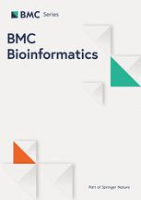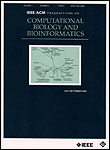
BRIEFINGS IN BIOINFORMATICS
Scope & Guideline
Pioneering Insights in Computational Biology
Introduction
Aims and Scopes
- Multi-Omincs Integration:
The journal emphasizes the integration of multi-omics data, allowing researchers to analyze complex biological systems and uncover novel insights into diseases and therapeutic targets. - Predictive Modeling and Machine Learning:
A core focus is on the development and application of predictive models using machine learning techniques to enhance the accuracy and efficiency of biological data interpretation. - Computational Tools and Databases:
The journal publishes articles on the creation and evaluation of computational tools and databases that facilitate various aspects of bioinformatics research. - Network Analysis and Systems Biology:
There is a consistent emphasis on network-based approaches for understanding biological interactions and systems-level insights into disease mechanisms. - Gene Function Prediction and Annotation:
The journal addresses methodologies for predicting gene functions and annotations, which are critical for understanding gene regulation and interactions. - Structural Bioinformatics:
Research involving structural predictions and dynamics of biomolecules is a significant area, contributing to drug design and understanding molecular interactions. - Clinical Applications and Precision Medicine:
BRIEFINGS IN BIOINFORMATICS explores the application of bioinformatics in clinical settings, particularly in precision medicine and personalized healthcare.
Trending and Emerging
- Deep Learning Applications:
Deep learning methodologies are rapidly becoming a focal point, with numerous studies exploring their application in various bioinformatics problems, including protein folding and drug discovery. - Graph-Based Approaches:
The use of graph-based methods for modeling biological interactions and networks is trending, as they provide powerful frameworks for integrating complex biological data. - Personalized Medicine and Genomic Data Integration:
There is a growing emphasis on personalized medicine, leveraging genomic data integration and machine learning to tailor treatments to individual patient profiles. - Structural Bioinformatics and Molecular Dynamics:
Research in structural bioinformatics, particularly involving molecular dynamics simulations and protein-ligand interactions, is gaining traction for its relevance in drug design. - Single-Cell Analysis Techniques:
Emerging techniques for analyzing single-cell data, including novel clustering and imputation methods, are increasingly featured, reflecting the importance of cellular heterogeneity. - Artificial Intelligence in Drug Discovery:
The integration of AI in drug discovery processes is a significant trend, with studies focusing on predictive models for drug-target interactions and therapeutic efficacy. - Network Pharmacology:
Network pharmacology is on the rise, with research exploring the complex interactions within biological networks to identify potential therapeutic targets.
Declining or Waning
- Traditional Statistical Methods:
There has been a noticeable decline in the emphasis on traditional statistical methods for data analysis as the field increasingly adopts machine learning and AI-based approaches. - Single-Omics Studies:
Research focused solely on single-omics (e.g., transcriptomics without integration with genomics or proteomics) is becoming less prevalent as the trend shifts towards multi-omics integration. - Basic Computational Techniques:
Basic computational techniques, such as simple sequence alignment algorithms, are being overshadowed by more advanced methods that leverage deep learning and complex network analyses. - Generalized Drug Discovery Models:
There is a decrease in the publication of generalized drug discovery models as the focus shifts to more specific and tailored approaches that integrate molecular dynamics and precise biological context.
Similar Journals

Briefings in Functional Genomics
Advancing the Frontiers of Functional GenomicsBriefings in Functional Genomics, published by Oxford University Press, serves as a crucial academic resource in the fields of biochemistry, genetics, and molecular biology. With an ISSN of 2041-2649 and an E-ISSN of 2041-2657, this esteemed journal explores innovative research and developments in functional genomics, with a commitment to advancing our understanding of genetic processes and their implications in health and disease. Ranking in the Q2 quartile for both Biochemistry and Genetics, and occupying a prominent Q1 status in the domain of interdisciplinary Medicine, the journal is positioned as a leading platform for researchers seeking to disseminate their findings to a global audience. Although it does not currently offer open access options, its accessibility through institutional subscriptions and its esteemed impact factor underscore its importance in the research community. Covering converging topics from 2010 to 2024, Briefings in Functional Genomics not only keeps pace with the rapidly evolving landscape of genomics but also stimulates collaboration and dialogue among scientists and industry professionals alike, making it an indispensable tool for researchers, practitioners, and students eager to engage with cutting-edge genomic science.

Precision Clinical Medicine
Empowering personalized medicine for every patient.Precision Clinical Medicine, published by Oxford University Press, is an esteemed open-access journal that has been at the forefront of clinical research since its inception in 2018. With an ISSN of 2096-5303, this journal specializes in the rapidly evolving field of precision medicine, which aims to tailor healthcare to individual patient characteristics, needs, and preferences. As a testament to its influence, Precision Clinical Medicine holds a remarkable rank of #34 out of 636 in the General Medicine category on Scopus, placing it within the 94th percentile of its field and earning a prestigious Q1 rating in 2023. Based in the United Kingdom, the journal not only provides open access content, ensuring that groundbreaking research is widely disseminated, but also serves as a crucial platform for innovations and discussions that shape modern medical practices. Researchers, professionals, and students alike will find valuable insights and influential studies that drive the future of personalized healthcare within its pages.

BMC BIOINFORMATICS
Advancing the Frontier of Biological Discovery through Computation.BMC Bioinformatics is a leading open-access journal published by BMC, dedicated to the rapidly evolving field of bioinformatics. With its inception in 2000, the journal has established itself as an essential resource for researchers, professionals, and students alike, disseminating high-quality research that bridges the gap between biology and computational science. BMC Bioinformatics holds a reputable Q1 ranking in Applied Mathematics and Computer Science Applications, and a Q2 ranking in both Biochemistry and Structural Biology, reflecting its significant impact in these interdisciplinary fields. The journal's broad scope encompasses innovative methodologies, tools, and applications that drive progress in biological research through computational approaches. With open access since its inception, the journal ensures unrestricted availability of cutting-edge research findings, promoting knowledge sharing and collaboration in the global scientific community. As it continues to publish advancements up to 2024, BMC Bioinformatics remains a cornerstone for those seeking to enhance their understanding of bioinformatics and its vital role in modern science.

GENERAL PHYSIOLOGY AND BIOPHYSICS
Bridging Biological Systems with Physical PrinciplesGENERAL PHYSIOLOGY AND BIOPHYSICS, published by AEPRESS SRO, is a pivotal journal in the fields of biophysics and physiology, dedicated to advancing knowledge and fostering research in these increasingly vital disciplines. Established in 1983 and set to converge in 2024, the journal provides a platform for scholarly articles that explore the intricate relationships between biological systems and physical principles. Its current category quartiles include Q3 in Biophysics and Q4 in Physiology, demonstrating a growing influence among researchers, with current Scopus ranks reflecting its commitment to quality and relevance. Despite not being an open-access publication, the journal remains a valuable resource for professionals and students aiming to stay informed on the latest discoveries and methodologies. By supporting interdisciplinary research and innovation, GENERAL PHYSIOLOGY AND BIOPHYSICS plays a crucial role in shaping the understanding of complex biological interactions and applications in medicine.

Journal of Integrative Bioinformatics
Unifying Disciplines to Decode Complex Biomedical ChallengesJournal of Integrative Bioinformatics, published by WALTER DE GRUYTER GMBH, is a leading open-access journal that has been at the forefront of the field since its inception in 2004. With an E-ISSN of 1613-4516, it serves as a crucial platform for researchers engaged in the interdisciplinary study of bioinformatics, blending insights from biology, computer science, and mathematics. Based in Germany, the journal is recognized for its impact in the realm of general medicine, boasting a Scopus rank of #172 out of 636 and placing in the 73rd percentile of its category. The journal continuously strives to disseminate high-quality research contributions that unify experimental and computational approaches to address complex biomedical questions. Targeted towards academics, professionals, and students alike, the Journal of Integrative Bioinformatics provides essential access to innovative research that enhances our understanding of integrative methodologies in medicine and beyond, especially with converged years spanning from 2008 to 2024.

Bioinformatics Advances
Transforming Biological Research Through Computational ExcellenceBioinformatics Advances, published by Oxford University Press, is an esteemed academic journal that serves as a vital platform for the dissemination of innovative research in the rapidly evolving fields of bioinformatics and computational biology. With a promising E-ISSN of 2635-0041, this journal has made significant strides since its inception in 2021, achieving a commendable Q1 ranking in both the Computer Science Applications and Genetics categories, alongside respectable Q2 rankings in Molecular Biology and Structural Biology as of 2023. Though currently not an open-access publication, its critical insights cater to an audience keen on advancing knowledge and technology in genomic studies and data analytics. The journal emphasizes high-quality research and aims to facilitate the integration of computational techniques within biological sciences, making it an essential resource for researchers, professionals, and students alike who seek to stay at the forefront of bioinformatics advancements.

Journal of Computational Biophysics and Chemistry
Innovating Computational Techniques for Biochemical BreakthroughsThe Journal of Computational Biophysics and Chemistry, published by World Scientific Publishing Co. Pte Ltd, is a distinguished platform dedicated to advancing the fields of biophysics and computational chemistry. With an ISSN of 2737-4165 and an E-ISSN of 2737-4173, this journal has garnered attention since its inception, earning a Q3 ranking in Computational Theory and Mathematics and Q4 rankings in both Computer Science Applications and Physical and Theoretical Chemistry as of 2023. The scope of the journal encompasses innovative research that integrates computational techniques with biochemical applications, making it essential reading for researchers, professionals, and students alike. With open access options available, the journal ensures that cutting-edge findings are easily accessible to a global audience, thereby fostering collaboration and innovation in the scientific community. Based in Singapore, the journal aims to converge ideas and methodologies from 2021 to 2024, paving the way for transformative insights in computational methods. Join a community at the forefront of research and applications that bridge disciplines through rigorous scholarship and pioneering discoveries.

COMPUTATIONAL BIOLOGY AND CHEMISTRY
Unraveling Complex Biological Mysteries with Computational PrecisionCOMPUTATIONAL BIOLOGY AND CHEMISTRY is a distinguished academic journal published by Elsevier Science Ltd, focusing on the dynamic intersection of computational biology, biochemistry, and chemistry. With an ISSN of 1476-9271 and an E-ISSN of 1476-928X, this journal is committed to disseminating high-quality research that employs computational techniques to solve complex biological and chemical problems. As of 2023, the journal holds a substantial impact factor reflecting its significance and rigorous peer-review process, categorized in the Q2 quartile for both Computational Mathematics and Organic Chemistry, alongside Q3 classifications in Biochemistry and Structural Biology. With a continuous publication history spanning from 2003 to 2024, it serves as a critical resource for researchers, professionals, and students alike. The journal offers various open access options, ensuring that vital research findings are accessible to a global audience, further enhancing collaboration across disciplines. Engage with cutting-edge studies and contribute to the evolving landscape of computational methodologies in the life sciences through this esteemed publication.

IEEE-ACM Transactions on Computational Biology and Bioinformatics
Bridging Biology and Technology with Cutting-Edge ResearchIEEE-ACM Transactions on Computational Biology and Bioinformatics is a prestigious journal published by the IEEE Computer Society, focusing on the interdisciplinary field of computational biology and bioinformatics. Established in 2004, this journal has made significant strides in contributing to our understanding of complex biological systems through quantitative methods and computational techniques, and it spans a converged publication period through 2024. As a notable resource with an impact factor that positions it in the second quartile in the domains of Applied Mathematics, Biotechnology, and Genetics, it serves as an essential platform for researchers and professionals seeking to disseminate their findings to a global audience. The journal ranks impressively in Scopus, with Applied Mathematics holding a rank of #38 out of 635 (94th percentile) and Genetics at #86 out of 347 (75th percentile), highlighting its significant influence in the scientific community. While the journal is not open-access, it provides valuable insights and cutting-edge research that are crucial for advancing the fields of bioinformatics and computational biology, making it indispensable for students, researchers, and practitioners alike.

Algorithms for Molecular Biology
Unlocking the complexities of life with cutting-edge algorithms.Algorithms for Molecular Biology, published by BMC, is a premier Open Access journal dedicated to advancing the field of molecular biology through innovative computational methods. Since its inception in 2006, the journal has provided a vital platform for researchers to share their findings and methodologies, covering a diverse range of topics at the intersection of applied mathematics, computational theory, and molecular biology. With a notable impact factor reflected in its Scopus ranks, including a Q2 classification in both applied mathematics and computational theory, as well as Q3 in molecular and structural biology, the journal plays an essential role in this rapidly evolving discipline. The wide accessibility of articles published under the Open Access model ensures that research findings reach a global audience, fostering collaboration and innovation amongst scientists and professionals alike. As we look towards converging years from 2006 to 2024, Algorithms for Molecular Biology continues to uphold the highest standards of scientific integrity and excellence, reinforcing its status as a key resource for those engaged in the profound complexities of molecular biology.